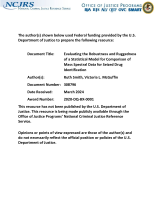Statistical methodologies
Out of home placement location and juvenile delinquency: The investigation of neighborhood impact on child welfare population's juvenile justice involvement
Development of a Probabilistic Multi-Class Model Selection Algorithm for High-Dimensional and Complex Data
Developing and Using a Serious Drug Abuser Scale in the Criminal Justice System: Executive Summary
Development and Properties of Kernel-based Methods for the Interpretation and Presentation of Forensic Evidence
Enhancing Equitable Forensic Identification: An Evaluation of Pelvic Morphology for Parity Detection and Age Estimation in Unidentified Skeletal Remains
Determining Economic Factors for Sex Trafficking in the United States Using Count Time Series Regression
Evaluating the Robustness and Ruggedness of a Statistical Model for Comparison of Mass Spectral Data for Seized Drug Identification
ATM: A distributed, collaborative, scalable system for automated machine learning
The sexual assault microbiome: Detecting contact when minimal male DNA is present.
Using Community-Based Participatory Research to Advance Transformative Credible Messenger Mentoring for Justice-Involved Youth of Color
The Mortal Tragedy: Analyzing Body Disposal Patterns in Homicide Cases
Reduced Overhead Training for Multi Reconfigurable Antennas With Beam-Tilting Capability
Investigating Disparities in Behavior and Care Between Alaska Native and White Victims of Sexual Violence: The Importance of Culturally Competent Nursing Care
Reliable Model Selection without Reference Values by Utilizing Model Diversity with Prediction Similarity
Fast Screening of Firearm Discharge Residues by Laser-Based Spectrochemical Methods, Electrochemical Sensors, and Chemometrics
Statistical Infrastructure for the Use of Error Rate Studies in the Interpretation of Forensic Evidence
Introduction and Initial Evaluation of a Novel Three-Dimensional Imaging and Analysis System for Firearm Forensics
Statistical Confirmation of Empirical Observations Concerning Tool Mark Striae
Contributions to ROC Curve and Likelihood Ratio Estimation for Forensic Evidence Interpretation
Booker and Beyond Analyzing Sentencing Reform and Exploring New Research Directions
This webinar features a discussion of previously published research on the U.S. Supreme Court’s 2005 Booker decision - which effectively transformed the United States Sentencing Guidelines from a mandatory, to an advisory, system. The presentation will address selected research findings from the last 15 years. Individual participants will briefly review their previous research findings with particular attention paid to the analytic methods used.
See the YouTube Terms of Service and Google Privacy Policy





